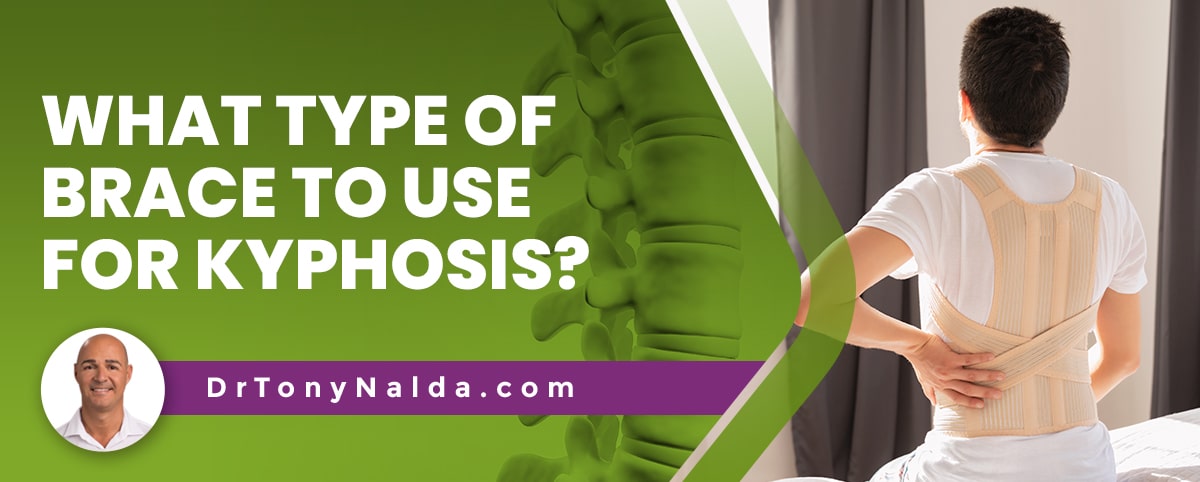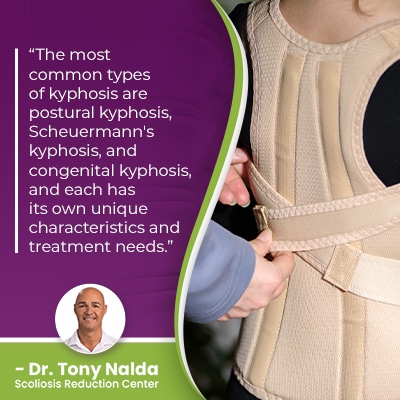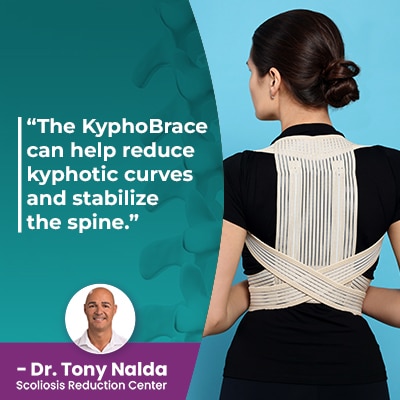Kyphosis Brace: What Type Of Brace To Use For Kyphosis?

When the spine develops an excessive degree of kyphosis in the thoracic spine, this can cause the upper back and shoulders to become excessively rounded forward, and this is because the spine's kyphotic curve bends backwards, away from the body's center.
There are a number of spinal conditions a person can develop that involves a loss of its healthy curves. Kyphosis is a spinal condition that involves an excessive kyphotic curve in the thoracic spine, causing a roundback appearance, and the corrective KyphoBrace can help with treatment.
There is a natural range of healthy spinal-curve sizes, but if a person's degree of kyphosis falls beyond a normal range, problems can occur, so let's start with what's considered a healthy spinal curve.
Table of Contents
The Spine's Healthy Curves
The spine's healthy curves make it stronger, more flexible, and better able to handle mechanical stress, and it's the spine's natural curves that make it appear straight when viewed from the front and/or back, and give it a soft 'S' shape when viewed from the sides.
In order for the spine to function optimally, it has to maintain its natural curves and alignment, but if one or more vertebral bodies become unnaturally tilted, this shifts the spine out of alignment, which can cause a number of issues.
The two main spinal curvature types are lordosis and kyphosis, and lordosis refers to the inwards spinal curves at the cervical and lumbar spinal sections (cervical land lumbar lordosis), and the kyphotic curve of the thoracic spine bends outwards (thoracic kyphosis).
There are three main spinal sections: the cervical spine (neck), thoracic spine (middle/upper back), and the lumbar spine (lower back).
The spine consists of vertebrae (bones of the spine) that are stacked on top of one another, and adjacent vertebrae are separated by an intervertebral disc: a spinal structure that's key to its ability to maintain its nature curves.
Now, as we mentioned, it's natural for these curvature sizes to vary from person to person, but when a curvature degree becomes excessive, falling beyond a normal range, this is when problems occur.
A healthy range of kyphosis-degree would fall between 20 and 40 degrees with excessive kyphosis, also known as hyperkyphosis, commonly diagnosed at 50+ degrees.
So what are some symptoms associated with hyperkyphosis?
Hyperkyphosis Symptoms
The main symptom of hyperkyphosis is how posture can be affected.
When the middle/upper back develops an excessive level of kyphosis, the spine bends outwards excessively, causing a pitched-forward appearance that gives the upper back and shoulders a roundback appearance.
In fact, the condition is commonly referred to as a roundback deformity because of how it affects posture and body positioning.
A healthy spine will have its natural curves in place and its vertebrae aligned, but when hyperkyphosis is an issue, it exposes the spine and its surroundings to uneven forces, and this includes the spine's surrounding muscles and nerves.
In addition to different severity levels ranging from mild kyphosis to severe cases, there are also different types of kyphosis, determined by causation, so treatment needs are case-specific.
Types of Kyphosis
 The most common types of kyphosis are postural kyphosis, Scheuermann's kyphosis, and congenital kyphosis, and each has its own unique characteristics and treatment needs.
The most common types of kyphosis are postural kyphosis, Scheuermann's kyphosis, and congenital kyphosis, and each has its own unique characteristics and treatment needs.
The most prevalent type is postural kyphosis, and this is the simplest form to treat because it's nonstructural, so doesn't involve a structural abnormality within the spine itself.
When treating kyphosis that's postural, this means the curve isn't rigid and that it can change with an active effort to correct the curve and stand up straight.
Postural kyphosis is commonly treated with physical therapy to improve posture and increase core strength so the spine is optimally supported by its surrounding muscles.
Scheuermann's kyphosis is a structural condition, so treatment is not as simple and has to impact it, first and foremost, on a structural level.
Scheuermann's kyphosis curves are rigid, and no change in position will reduce the curve, and Scheuermann's curves will progress over time.
Scheuermann's juvenile kyphosis is diagnosed in patients between the ages of 3 and 10 and is most commonly diagnosed during adolescence, in young adults between the ages of 10 and 18.
Congenital kyphosis is also a structural condition as it's caused by a malformed spine that develops in utero; oftentimes, this involves vertebrae forming into more of a triangular shape, than rectangular, as they should be, and this causes vertebral wedging and excessive kyphosis; and this is also an issues in Scheuermann's disease.
Other times, the malformation can involve vertebrae failing to form into distinct and separate vertebral bodies, becoming fused together as one.
Kyphosis Treatment: KyphoBrace
Here at the Scoliosis Reduction Center, I've treated a variety of spinal conditions with nonsurgical treatment, kyphosis included, with a non-surgical conservative treatment approach with the goal of permanent correction.
I also integrate different types of treatment so every treatment plan can be fully customized to address key patient/condition variables, and in addition to condition-specific chiropractic care, physical therapy, and rehabilitation, corrective bracing plays a role.
For my scoliosis patients, I opt for the ultra-corrective ScoliBrace because this is a modern brace representing the culmination of what we've learned about scoliosis treatment efficacy over the years.
The ScoliBrace addresses many of the shortcomings associated with traditional brace design that only addresses scoliosis as a 2-dimensional condition, when its rotational component makes it a 3-dimensional condition.
A traditional back brace is known to squeeze the spine unnaturally, which weakens it over time and increases postural deviation.
KyphoBrace
Based on the success of the ScoliBrace, a sister product was designed to address kyphosis: the KyphoBrace.
 The KyphoBrace can help reduce kyphotic curves and stabilize the spine.
The KyphoBrace can help reduce kyphotic curves and stabilize the spine.
Of the most common types of kyphosis mentioned, Scheuermann's kyphosis and thoracic and/or thoracolumbar kyphosis, are the condition types known as the most responsive to the use of the KyphoBrace in treatment.
The thoracic spine is the largest spinal section, and in some instances of unnatural vertebral changes, they can involve two spinal sections, so a diagnosis of thoracolumbar kyphosis means an excessive kyphotic curve has developed in the lower thoracic spine and the upper lumbar spine (thoracolumbar spine).
In skeletally immature patients, braces can be a particularly-effective treatment option by augmenting corrective treatment results and reducing an abnormal curvature of the spine.
So when it comes time to treat kyphosis, the KyphoBrace can help work towards a curvature reduction on a structural level by reducing the kyphosis angle, and brace treatment can work by pushing the spine into a corrective position.
While there are never treatment guarantees, the KyphoBrace can also help prevent future progression and is recommended for addressing kyphotic curves between 50 and 80 degrees.
The brace works via a pair of pivoting shoulder paddles that push the spine into a straighter alignment by hyperextending the upper thoracic spine, which reduces the curve and prevents further curve progression.
The way the brace holds the upper spine in the extended corrected position can, over time, start to change the spine's structure while the spine is being supported and stabilized by the brace.
Just like the ScoliBrace, the KyphoBrace is custom-designed so it's bespoke to a patient's body and condition type, and is more comfortable to wear, making it more likely that young patients will comply and wear the brace as prescribed; brace wear can only be effective if it's worn as prescribed, for the appropriate lengths of time.
Compliance is an issue associated with traditional braces that are mass produced and not as comfortable, or discreet, to wear, and the KyphoBrace addresses this by using state-of-the-art scanning technology, a series of comprehensive measurements and images, and making the brace easily open at the front.
The KyphoBrace is also available in a variety of patterns and colors so kyphosis patients can further customize their kyphosis braces.
So not only does the KyphoBrace work towards reducing the kyphotic curve of the thoracic spine and/or the thoracolumbar spine, it can also prevent progression and provide the spine with optimal support and stabilization during treatment.
Conclusion
If a patient develops an excessive degree of kyphosis in the thoracic spine, this is a kyphosis degree of 50+ degrees, and this is also referred to as roundback due to the appearance it gives the upper back and shoulders.
While postural kyphosis is caused by chronic poor posture, Scheuermann kyphosis and congenital kyphosis are structural spinal conditions that require more intensive treatment.
In order to restore a patient's healthy level of kyphosis, I proactively start treatment as close to the time of diagnosis as possible; untreated Scheuermann's disease will get worse over time.
Kyphosis progressing means the kyphotic curve is increasing in size, exposing the body to more uneven forces, and increasing effects.
The spine gets more rigid with progression, making it less responsive to treatment and can also make it difficult for patients to perform certain therapeutic exercises (trunk extensor strengthening exercises) as part of treatment, so it's always best to be proactive with treatment.
Patients diagnosed with kyphosis can benefit from a conservative chiropractic treatment approach that combines condition-specific chiropractic care that can work towards repositioning the curve's most-tilted vertebrae back into alignment with the rest of the spine.
Condition-specific physical therapy can also help by increasing core strength so the spine can receive optimal support from its surrounding muscles, improving posture, and activating certain areas of the brain or improved brain-body communication.
The KyphoBrace can be particularly effective on growing spines by pushing the spine into a corrective position and addressing the condition's 3-dimensional nature.
In brace corrections, a patient's level of skeletal maturity is important and in addition to augmenting corrective treatment results, for those experiencing pain, a back brace can also help with pain relief.
Dr. Tony Nalda
DOCTOR OF CHIROPRACTIC
After receiving an undergraduate degree in psychology and his Doctorate of Chiropractic from Life University, Dr. Nalda settled in Celebration, Florida and proceeded to build one of Central Florida’s most successful chiropractic clinics.
His experience with patients suffering from scoliosis, and the confusion and frustration they faced, led him to seek a specialty in scoliosis care. In 2006 he completed his Intensive Care Certification from CLEAR Institute, a leading scoliosis educational and certification center.
About Dr. Tony Nalda
 Ready to explore scoliosis treatment? Contact Us Now
Ready to explore scoliosis treatment? Contact Us Now





